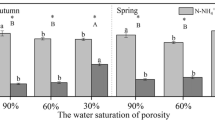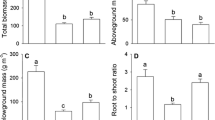Abstract
In this field study we show that temperate coastal heath vegetation has a significant off-season uptake potential for nitrogen, both in the form of ammonium and as glycine, throughout winter. We injected 15N-ammonium and 15N 2×(13C)-glycine into the soil twice during winter and once at spring. The winter temperatures were similar to those of an average winter in the northern temperate region of Europe, with only few days of soil temperatures below zero or above 5°C. The vegetation, consisting of the evergreen dwarf shrub Calluna vulgaris, the deciduous dwarf shrub Salix arenaria, and the graminoids Carex arenaria and Deschampsia flexuosa, showed high root uptake of both forms of nitrogen, both 1 day after labelling and after a month, in species specific temporal patterns. Plant uptake of 13C was not significant, providing no further evidence of intact uptake of glycine. Translocation of the labelled nitrogen to shoots was generally evident after 1 month and increased as spring approached, with different translocation strategies in the three plant functional types. Furthermore, only the graminoids showed shoot growth during winter. Increasing plant nitrogen concentration from fall to spring at temperate heaths may, hence, be due to nitrogen uptake. Our results suggest that the potential for nitrogen uptake in plants at winter is of the same order of magnitude as at summer. Hence, winter nitrogen uptake in ecosystems in the temperate/boreal region should be considered when making annual nitrogen budgets of heath ecosystems, and the view of plant nutrient uptake as low in this climatic region during winter should be revised.








Similar content being viewed by others
References
Abuarghub SM, Read DJ (1988) The biology of mycorrhiza in the Ericaceae XI. The distribution of nitrogen in soil of a typical upland Callunetum with special reference to the ’free’ amino acids. New Phytol 108:425–431
Addy HD, Schaffer GF, Miller MH, Peterson RL (1994) Survival of the external mycelium of a VAM fungus in frozen soil over winter. Mycorrhiza 5:1–5
Aerts R, Chapin III FS (2000) The mineral nutrition of wild plants revisited: a re-evaluation of processes and patterns. Adv Ecol Res 30:1–67
Bardgett RD, Streeter TC, Bol R (2003) Soil microbes compete effectively with plants for organic-nitrogen inputs to temperate grasslands. Ecology 84:1277–1287
Bausenwein U, Millard P, Raven JA (2001) Remobilized old-leaf nitrogen predominates for spring growth in two temperate grasses. New Phytol 152:283–290
Brooks PD, Schmidt SK, Williams MW (1997) Winter production of CO2 and N2O from alpine tundra: environmental controls and relationship to inter-system C and N fluxes. Oecologia 110:403–413
Catt JA, Howse KR, Christian DG, Lane PW, Harris GI, Goss MJ (1998) Strategies to decrease nitrate leaching in the Brimstone Farm Experiment Oxfordshire, UK, 1988–1993: the effects of winter cover crops and unfertilised grass leys. Plant Soil 203:57–69
Chapin III FS, Shaver GR, Kedrowski RA (1986) Environmental controls over carbon, nitrogen and phosphorus fractions in Eriophorum vaginatum in an Alaskan tussock tundra. J Ecol 74:167–195
Danish Meteorological Institute (2004) vejrarkiv - weather archive. http://www.dmi.dk/dmi/index/danmark/vejrarkiv.htm. Cited 28 May 2004
Dawson TE, Brooks PD (2001) Fundamentals of stable isotope chemistry and measurement. In: Unkovich M, Pate J, McNeill A, Gibbs DJ (eds) Stable isotope techniques in the study of biological processes and functioning of ecosystems. Kluwer, Dordrecht, pp 1–18
Eckstein RL, Karlsson PS, Weih M (1998) The significance of resorption of leaf resources for shoot growth in evergreen and deciduous woody plants from a subarctic environment. Oikos 81:567–575
Ellenberg H, Spatz G, Pletl L, Mangstl A (1979) Zeigerwerte der Gefäßpflanzen Mitteleuropas. Scripta Geobotanica 9
Fischer W-N, André B, Rentsch D, Krolkiewicz S, Tegeder M, Breitkreuz K, Frommer WB (1998) Amino acid transport in plants. TRENDS Plant Sci 3:188–195
Giovanetti M, Mosse B (1980) An evaluation of techniques for measuring vesicular arbuscular mycorrhizal infection in roots. New Phytol 84:489–500
Grogan P, Jonasson S (2003) Controls on annual nitrogen cycling in the understory of a subarctic birch forest. Ecology 84:202–218
Grogan P, Illeris L, Michelsen A, Jonasson S (2001) Respiration of recently-fixed plant carbon dominates mid-winter ecosystem CO2 production in sub-arctic heath tundra. Climatic Change 50:129–142
Hobbie SE, Chapin FS III (1996) Winter regulation of tundra litter carbon and nitrogen dynamics. Biogeochemistry 35:327–338
IPCC (2004) Climate change 2001 the scientific basis. http://www.grida.no/climate/ipcc_tar/wg1/index.htm. Cited 28 May 2004
Jensen KD, Beier C, Michelsen A, Emmett BA (2003) Effects of experimental drought on microbial processes in two temperate heathlands at contrasting water conditions. Appl Soil Ecol 24:165–176
Jonasson S (1989) Implications of leaf longevity, leaf nutrient re-absorption and translocation for the resource economy of five evergreen plant species. Oikos 56:121–131
Jonasson S, Michelsen A, Schmidt IK (1999) Coupling of nutrient cycling and carbon dynamics in the arctic, integration of soil microbial and plant processes. Appl Soil Ecol 11:135–146
Jonasson S, Castro J, Michelsen A (2004) Litter, warming and plants affect respiration and allocation of soil microbial and plant C, N and P in arctic mesocosms. Soil Biol Biochem 36:1129–1139
Karlsson PS, Eckstein RL, Weih M (2000) Seasonal variation in 15N natural abundance in subarctic plants of different life-forms. Ecoscience 7:365–369
Kielland K (1994) Amino acid absorption by Arctic plants: implications for plant nutrition and nitrogen cycling. Ecology 75:2373–2383
Kielland K (1995) Landscape patterns of free amino acids in arctic tundra soils. Biogeochemistry 31:85–98
Kristensen HL, Henriksen K (1998) Soil nitrogen transformations along a successional gradient from Calluna heathland to Quercus forest at intermediate atmospheric nitrogen deposition. Appl Soil Ecol 8:95–109
Lamaze T, Pasche F, Pornon A (2003) Uncoupling nitrogen requirements for spring growth from root uptake in a young evergreen shrub (Rhododendron ferrugineum). New Phytol 159:637–644
Larsen KS, Jonasson S, Michelsen A (2002) Repeated freeze-thaw cycles and their effects on biological processes in two arctic ecosystem types. Appl Soil Ecol 21:187–195
Lipson DA, Näsholm T (2001) The unexpected versatility of plants: organic nitrogen use and availability in terrestrial ecosystems. Oecologia 128:305–316
Malmer N (1974) Scandinavian approach to the vegetation science. Meddelanden från Avdelingen för Ekologisk Botanik Lunds Universitet 1
McKane RB, Rastetter EB, Shaver GR, Nadelhoffer KJ, Giblin AE, Laundre JA, Chapin FS III (1997) Climatic effects on tundra carbon storage inferred from experimental data and a model. Ecology 78:1170–1187
McKane RB, Johnson LC, Shaver GR, Nadelhoffer KJ, Rastetter EB, Fry B, Giblin AE, Kielland K, Kwiatkowski BL, Laundre JA, Murray G (2002) Resource-based niches provide a basis for plant species diversity and dominance in arctic tundra. Nature 415:68–71
Michelsen A, Quarmby C, Sleep D, Jonasson S (1998) Vascular plant 15N natural abundance in heath and forest tundra ecosystems is closely correlated with presence and type of mycorrhizal fungi in roots. Oecologia 115:406–418
Micromass-GV Instruments (2002) IsoPrime-EA users manual and isoprime users guide
Miller GR (1979) Quantity and quality of the annual production of shoots and flowers by Calluna vulgaris in north-east Scotland. J Ecol 67:109–129
Nadelhoffer KJ, Giblin AE, Shaver GR, Laundre JA (1991) Effects of temperature and substrate quality on element mineralization in six arctic soils. Ecology 72:242–253
Näsholm T, Persson J (2001) Plant acquisition of organic nitrogen in boreal forests. Physiol Plantarum 111:419–426
Näsholm T, Ekblad A, Nordin A, Giesler R, Högberg M, Högberg P (1998) Boreal forest plants take up organic nitrogen. Nature 392:914–916
Näsholm T, Huss-Daniel K, Högberg P (2000) Uptake of organic nitrogen in the field by four agriculturally important plant species. Ecology 81:1155–1161
National Environmental Research Institute Denmark (2002) Atmosfærisk deposition nr. 418. http://www.dmu.dk/1_viden/2_Publikationer/3_fagrapporter/rapporter/FR418.pdf. Cited 28 May 2004
Nordin A, Schmidt IK, Shaver GR (2004) Nitrogen uptake by arctic soil microbes and plants in relation to soil nitrogen supply. Ecology 85:955–962
Persson J, Högberg P, Ekblad A, Högberg M, Nordgren A, Näsholm T (2003) Nitrogen acquisition from inorganic and organic sources by boreal forest plants in the field. Oecologia 137:252–257
Ritter WF, Scarborough RW, Chirnside AEM (1998) Winter cover crops as best management practice for reducing nitrogen leaching. J Contam Hydrol 34:1–15
SAS Institute Inc. (1999) The SAS system for windows
Schadt CW, Martin AP, Lipson DA, Schmidt SK (2003) Seasonal dynamics of previously unknown fungal linages in tundra soils. Science 301:1359–1361
Schimel JP, Chapin FS III (1996) Tundra plant uptake of amino acid and NH +4 nitrogen in situ: plants compete well for amino acid N. Ecology 77:2142–2147
Schimel JP, Bilbrough C, Welker JM (2004) Increased snow depth affects microbial activity and nitrogen mineralization in two Arctic tundra communities. Soil Biol Biochem 36:217–227
Schmidt SK, Lipson DA (2004) Microbial growth under snow: Implications for nutrient and allelochemical availability in temperate soils. Plant Soil 259:1–7
Schmidt S, Stewart GR (1999) Glycine metabolism by plant roots and its occurrence in Australian plant communities. Aust J Plant Physiol 26:253–264
Schmidt IK, Jonasson S, Michelsen A (1999) Mineralization and microbial immobilization of N and P in arctic soils in relation to season, temperature and nutrient amendment. Appl Soil Ecol 11:147–160
Sommerfeld RA, Moiser AR, Musselman RC (1993) CO2, CH4 and N2O flux through a Wyoming snowpack for global budgets. Nature 361:140–142
Starr G, Oberbauer SF (2003) Photosynthesis of arctic evergreens under snow: implications for tundra ecosystem carbon balance. Ecology 84:1415–1420
Svensson KS, Clarholm M (1994) Dynamics of biomass, nitrogen and carbon in shoots and roots of a ryegrass catch crop during winter. Swed J Agric Res 24:77–84
Weih M (2000) Growth of mountain birch seedlings in early-successional patches a year-round perspective. Plant Biol 2:428–436
Woolhouse HW, Kwolek AVA (1981) Seasonal growth and flowering rythms in European heathlands. In: Spect RL (ed) Ecosystems of the world 9B; heathlands and related shrublands. Elsevier, Amsterdam, pp 29–38
Zobel R (2003) Fine roots—discarding flawed assumptions. New Phytol 160:273–280
Acknowledgements
The Danish Natural Science Research Council is acknowledged for the funding of the Isotope Ratio Mass Spectrometer, and the Svend G. Fiedler Foundation is acknowledged for support of L.C.A. We sincerely thank Jonatan Kutchinsky for assistance with soil sampling, Karina E. Clemmesen and Lise Frederiksen for assistance with mycorrhiza and mosses, and two anonymous reviewers for constructive comments on an earlier version of the manuscript.
Author information
Authors and Affiliations
Corresponding author
Additional information
Communicated by Jim Ehleringer
Rights and permissions
About this article
Cite this article
Andresen, L.C., Michelsen, A. Off-season uptake of nitrogen in temperate heath vegetation. Oecologia 144, 585–597 (2005). https://doi.org/10.1007/s00442-005-0044-1
Received:
Accepted:
Published:
Issue Date:
DOI: https://doi.org/10.1007/s00442-005-0044-1




